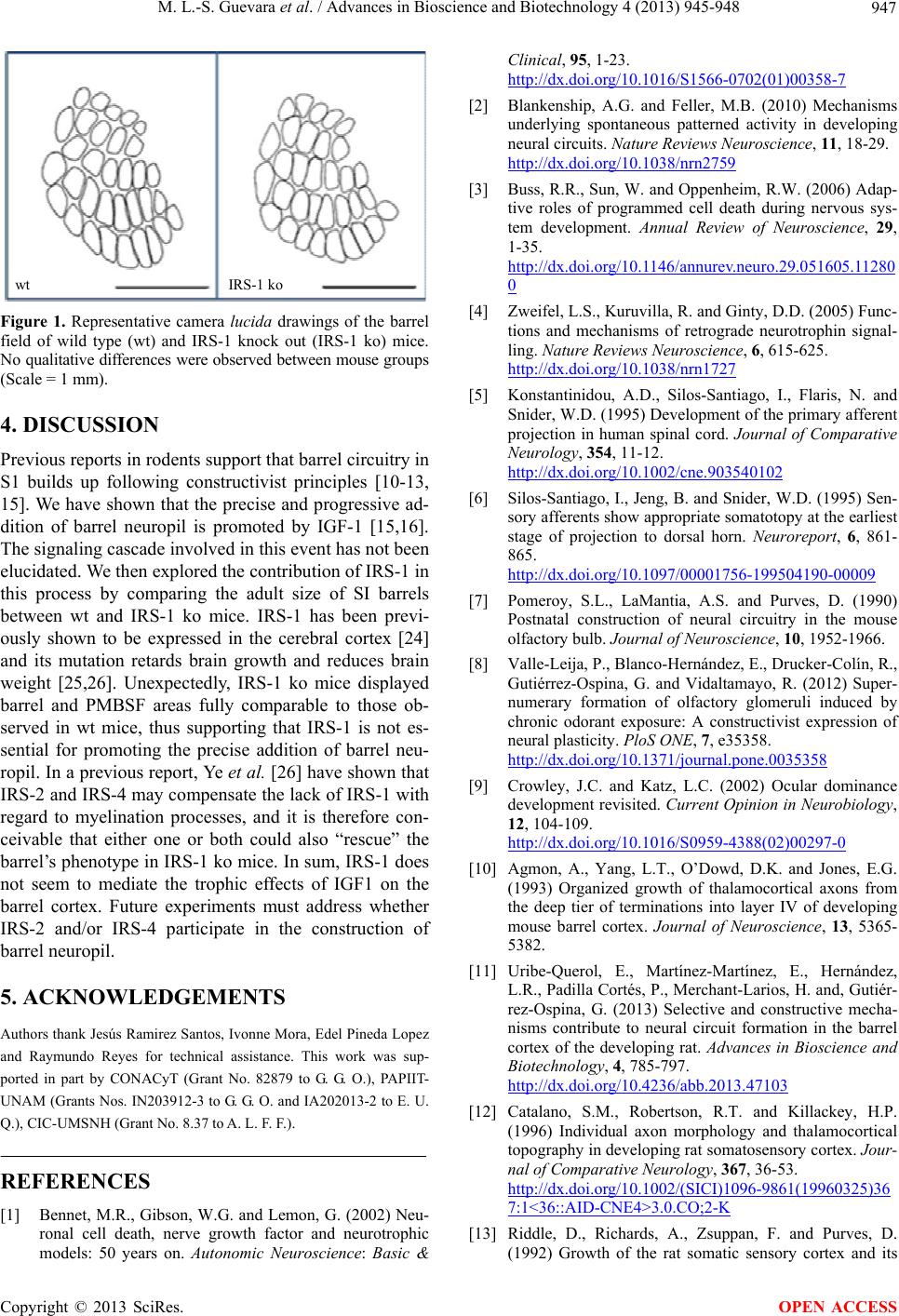
M. L.-S. Guevara et al. / Advances in Bioscience and Biotechnology 4 (2013) 945-948 947
wt IRS-1 ko
Figure 1. Representative camera lucida drawings of the barrel
field of wild type (wt) and IRS-1 knock out (IRS-1 ko) mice.
No qualitative differences were observed between mouse groups
(Scale = 1 mm).
4. DISCUSSION
Previous reports in rodents support that barrel circuitry in
S1 builds up following constructivist principles [10-13,
15]. We have shown that the precise and progressive ad-
dition of barrel neuropil is promoted by IGF-1 [15,16].
The signaling cascade involved in this event has not been
elucidated. We then explored the contribution of IRS-1 in
this process by comparing the adult size of SI barrels
between wt and IRS-1 ko mice. IRS-1 has been previ-
ously shown to be expressed in the cerebral cortex [24]
and its mutation retards brain growth and reduces brain
weight [25,26]. Unexpectedly, IRS-1 ko mice displayed
barrel and PMBSF areas fully comparable to those ob-
served in wt mice, thus supporting that IRS-1 is not es-
sential for promoting the precise addition of barrel neu-
ropil. In a previous report, Ye et al. [26] have shown that
IRS-2 and IRS-4 may compensate the lack of IRS-1 with
regard to myelination processes, and it is therefore con-
ceivable that either one or both could also “rescue” the
barrel’s phenotype in IRS-1 ko mice. In sum, IRS-1 does
not seem to mediate the trophic effects of IGF1 on the
barrel cortex. Future experiments must address whether
IRS-2 and/or IRS-4 participate in the construction of
barrel neuropil.
5. ACKNOWLEDGEMENTS
Authors thank Jesús Ramirez Santos, Ivonne Mora, Edel Pineda Lopez
and Raymundo Reyes for technical assistance. This work was sup-
ported in part by CONACyT (Grant No. 82879 to G. G. O.), PAPIIT-
UNAM (Grants Nos. IN203912-3 to G. G. O. and IA202013-2 to E. U.
Q.), CIC-UMSNH (Grant No. 8.37 to A. L. F. F.).
REFERENCES
[1] Bennet, M.R., Gibson, W.G. and Lemon, G. (2002) Neu-
ronal cell death, nerve growth factor and neurotrophic
models: 50 years on. Autonomic Neuroscience: Basic &
Clinical, 95, 1-23.
http://dx.doi.org/10.1016/S1566-0702(01)00358-7
[2] Blankenship, A.G. and Feller, M.B. (2010) Mechanisms
underlying spontaneous patterned activity in developing
neural circuits. Nature Reviews Neuroscience, 11, 18-29.
http://dx.doi.org/10.1038/nrn2759
[3] Buss, R.R., Sun, W. and Oppenheim, R.W. (2006) Adap-
tive roles of programmed cell death during nervous sys-
tem development. Annual Review of Neuroscience, 29,
1-35.
http://dx.doi.org/10.1146/annurev.neuro.29.051605.11280
0
[4] Zweifel, L.S., Kuruvilla, R. and Ginty, D.D. (2005) Func-
tions and mechanisms of retrograde neurotrophin signal-
ling. Nature Reviews Neuroscience, 6, 615-625.
http://dx.doi.org/10.1038/nrn1727
[5] Konstantinidou, A.D., Silos-Santiago, I., Flaris, N. and
Snider, W.D. (1995) Development of the primary afferent
projection in human spinal cord. Journal of Comparative
Neurology, 354, 11-12.
http://dx.doi.org/10.1002/cne.903540102
[6] Silos-Santiago, I., Jeng, B. and Snider, W.D. (1995) Sen-
sory afferents show appropriate somatotopy at the earliest
stage of projection to dorsal horn. Neuroreport, 6, 861-
865.
http://dx.doi.org/10.1097/00001756-199504190-00009
[7] Pomeroy, S.L., LaMantia, A.S. and Purves, D. (1990)
Postnatal construction of neural circuitry in the mouse
olfactory bulb. Journal of Neuroscience, 10, 1952-1966.
[8] Valle-Leija, P., Blanco-Hernández, E., Drucker-Colín, R.,
Gutiérrez-Ospina, G. and Vidaltamayo, R. (2012) Super-
numerary formation of olfactory glomeruli induced by
chronic odorant exposure: A constructivist expression of
neural plasticity. PloS ONE, 7, e35358.
http://dx.doi.org/10.1371/journal.pone.0035358
[9] Crowley, J.C. and Katz, L.C. (2002) Ocular dominance
development revisited. Current Opinion in Neurobiology,
12, 104-109.
http://dx.doi.org/10.1016/S0959-4388(02)00297-0
[10] Agmon, A., Yang, L.T., O’Dowd, D.K. and Jones, E.G.
(1993) Organized growth of thalamocortical axons from
the deep tier of terminations into layer IV of developing
mouse barrel cortex. Journal of Neuroscience, 13, 5365-
5382.
[11] Uribe-Querol, E., Martínez-Martínez, E., Hernández,
L.R., Padilla Cort és, P., Merchant-Larios, H. and, Gutiér-
rez-Ospina, G. (2013) Selective and constructive mecha-
nisms contribute to neural circuit formation in the barrel
cortex of the developing rat. Advances in Bioscience and
Biotechnology, 4, 785-797.
http://dx.doi.org/10.4236/abb.2013.47103
[12] Catalano, S.M., Robertson, R.T. and Killackey, H.P.
(1996) Individual axon morphology and thalamocortical
topography in developing rat somatosensory cortex. Jour-
nal of Comparative Neurology, 367, 36-53.
http://dx.doi.org/10.1002/(SICI)1096-9861(19960325)36
7:1<36::AID-CNE4>3.0.CO;2-K
[13] Riddle, D., Richards, A., Zsuppan, F. and Purves, D.
(1992) Growth of the rat somatic sensory cortex and its
Copyright © 2013 SciRes. OPEN ACCESS